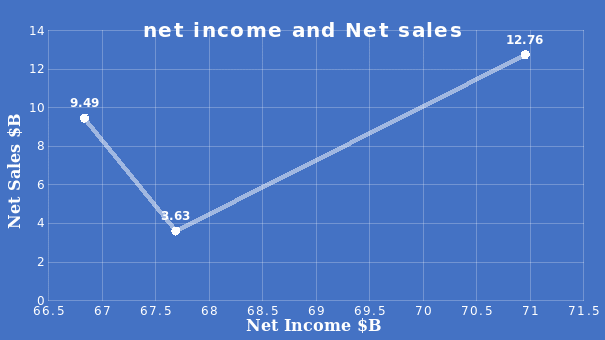Proctor and Gamble (P&G) manufactures and sells consumer products and reports in five industry sections: Fabric and Home Care, Baby, Feminine and Family Care, Beauty, Grooming, and Health Care. P&G’s Febreze products fall in the Fabric and Home Care industry unit; this segment’s significant competitors are Colgate-Palmolive and Johnson and Johnson (PG’s Competition by Segment and its Market, 2021). “Fabric care alone accounted for sales of over $15b, and P&G is the global leader in the sector with around 25% market share”, making it a monopolistic competition (Smithson, 2017, pp. 1).
P&G is in a market where their products compete over similar but non-identical goods, such as Febreze, in the air freshener business. There are no major barriers to movement due to the freedom to enter or leave the market. In Figure 1, the comparison between P&G and their competitors in net income, book value per share, and the net income growth percentage based on data from the website Csimartket and Macotrends are presented (PG’s Competition by Segment and its Market, 2021; The Procter & Gamble Company – Strategy, SWOT and Corporate Finance Report):
Data comparison with major competition
Procter and Gamble utilize separation as its nonexclusive methodology for the upper hand. Separation includes strengthening the uniqueness of the business and its items to attract objective clients. For instance, the organization offers excellent cleaning specialists, similar to Tide clothing cleanser, at moderate costs. In view of this nonexclusive technique, a reasonable key target is to maintain P and G’s high speculations for Research and Development (R & D) to guarantee high-caliber and vital items (Smithson, 2017). In this situation, Procter and Gamble features quality and incentives in its purchaser products.
Typically, Proctor and Gamble operate in an oligopoly structure, whereby all the firms in the market in this particular niche have less influence. It is one of the powerful strategies that companies use to eliminate competition. There are only two firms in this oligopoly structure that can challenge Proctor and Gamble’s productivity. An oligopoly market structure’s objective is to sustain a particular number of firms in the business operation. However, Proctor and Gamble rank top in terms of performance, making it the most competitive company compared to other firms. For instance, the company has experienced increased net income for the last three years, with an accumulative income of $9.845 billion in 2018, $3.634 billion in 2019, and $12.764 billion in 2020. Although the company faced financial turmoil in 2019, there has been a substantial increment in terms of revenues. Overall, the company makes effective use of its complex structure and resources.
Consequently, Johnson and Johnson’s Company has been consistent in its net income figures with a total of $15.297 billion in 2018, $15.119 billion in 2019, and $16.986 billion in 2020. Net income is a vital entity that reflects the company’s progress and performance over a certain period. Technically, proctor and Gamble have a strong competitive advantage, making it thrive effectively in the market. Moreover, the sales growth has a positive trend for both the company and its competitor. Proctor and Gamble’s sales growth rose from 2.73% to 4.83% as of 2020, reflecting growth. Markets structure defines a company’s strength and the overall dividends realized after a certain period. The total accumulated net sales in 2019 are $66.832 billion, $67.684 billion in 2018, and $70.95 billion as of 2020 (“The Proctor and Gamble SEC-10 K Report,” 2020). Below is a graph presentation and a table illustrating the relationship between net sales and net income variables.
Net Sales and Income Variables

The above graph shows an increasing trend after a shortfall that was incurred in 2019. The net income is increasing with an increase in net sales, which reflects health performance. The two variables illustrate the market structure in terms of performance in the beauty industry. Depending on how the market structure is changed, it can have a devastating effect on the company. Consequently, it can also positively impact the firm’s performance; thus, changing market structure is very important to analyze the market niche. In case Proctor and Gamble changes its market structure, there are high chances of losing value in the beauty industry. It has currently increased its market value, giving it a factual background to compete with giant companies such as Johnson and Johnson.
Additionally, if Proctor and Gamble changes the market structure, it might experience challenges in entering new markets, hence surging its market cap. As an oligopoly company, it has a high chance to tap new market opportunities compared to new entrants. It would be a great challenge for it to thrive in other market niches (Stackelberg, 2020).
However, several viable reasons can push the company to change its market structure, for example, if the monetary policy is not favorable to a specific market niche or favors a particular market niche. Notably, this would be a wrong turn for the company, considering the USA has the most favorable monetary policies in the world. Proctor and Gamble have a strong competitive advantage to compete both locally and internationally. Comparing net sales, net income, and sales growth, it has a stable background to overtake the rival Johnson and Johnson firm.
References
P&G Fabric & Home Care advertising & marketing assignments. (n.d.). Adbrands. Web.
PG’s Competition by Segment and its Market. (2021). Web.
Smithson, N. (2017). Procter & Gamble’s Generic Strategy & Intensive Growth Strategies. Panmore Institute. Web.
Stackelberg, H. (2020). Market structure and Equilibrium. Springer.
The Procter & Gamble Company – Strategy, SWOT and Corporate Finance Report. Marketline. n.d. Web.
The Proctor and Gamble SEC-10 K Report. (2020). Web.
